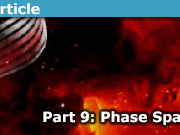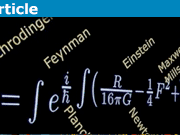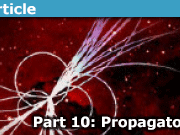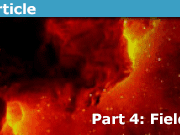Learn About Vacuum Fluctuations in Experimental Practice
This Insight Article is a sequel of the Insight Articles ”The Physics of Virtual Particles”, “Misconceptions about Virtual Particles“ , and ”The Vacuum Fluctuation Myth”, which make precise what a virtual particle is, what being real means, document some of the liberties taken in physics textbooks in the use of this concept, mention the most prominent misuses, and document the origin of some of the associated myths. In short, the concept of virtual particles is well-defined and useful when restricted to its use in Feynman diagrams and associated technical discussions. But it is highly misleading when used to argue about vacuum fluctuations as if these were processes happening in space and time. The latter is a frequent misunderstanding, a myth that has not the slightest basis in particle physics.
However, one meets occasionally mythical claims even in the scientific literature. Therefore it pays to look at a representative recent paper in which vacuum fluctuations play a seemingly prominent role, and answer the question: How do vacuum fluctuations look in practice?
http://science.sciencemag.org/content/350/6259/420 is the official web page for accessing a paper from Science by Riek and collaborators called ”Direct sampling of electric-field vacuum fluctuations” (Science 23 Oct 2015: Vol. 350, Issue 6259, pp. 420-423). A total of nine (9!) scientists take credit for having achieved that, so their jointly presented evidence should have some weight.
The journal web page, where Science readers are introduced to the paper, tries to generate publicity for the paper by placing the vacuum fluctuation myth in front of the main text:
According to quantum mechanics, a vacuum is not empty space. A consequence of the uncertainly principle is that particles or energy can come into existence for a fleeting moment.
Scientific publications in quantum optics typically use more careful language, and so do the authors of the paper, who write in the abstract something much milder:
The ground state of quantum systems is characterized by zero-point motion. This motion, in the form of vacuum fluctuations, is generally considered to be an elusive phenomenon that manifests itself only indirectly. Here, we report direct detection of the vacuum fluctuations of electromagnetic radiation in free space.
But still, it is an extraordinary claim that gives vacuum fluctuations the appearance of reality. Thus a closer look at their paper is called for.
Towards the end of their paper, they write:
In our study, we directly monitored vacuum fluctuations without amplifying them. The only effective part […] of the operator that extracts the variance of the field in Eq. 4 indicates that vacuum fluctuations correspond to photons, which spontaneously arise and vanish in the ground state. Time-energy uncertainty demands that virtual excitations have a limited lifetime on the order of their oscillation cycle (32). The subcycle temporal resolution provided by the ultrashort probe ensures that we can directly detect effects originating from purely virtual photons.
The first two sentences are still phrased in cautious language, as the word ‘indicates’ hints at a tentative finding only. But then they assert the vacuum fluctuation myth about ”photons, which spontaneously arise and vanish in the ground state.” The reference [32] they give to justify this indication is only to another paper by one of the authors, not – as one should expect for such a revolutionary result claimed – a basic reference where one could see a detailed derivation of how these photons arise spontaneously. Indeed, there are no such references since spontaneous processes happen only in unstable objects, but the vacuum is completely stable. And in the final sentence, they forgot their moderation: they announce – without giving any further argument – their surprising claim ”that we can directly detect effects originating from purely virtual photons”. The justification is completely lacking…
But let us look at their experimental findings. On closer reading of the paper, one finds that what fluctuates in the experiment is the electro-optical signal detected, not the vacuum. The electro-optical signal is the only thing measured, and it exhibits fluctuations. Thus what is measured are fluctuations of the signal, not of the vacuum.
So let us look at the evidence provided for their claim. The vacuum (whose fluctuations were allegedly observed) appears only indirectly – in spite of the title of the paper and the advertisement in the abstract -, namely in the form of a theoretical contribution to the variance of this signal in eq. (7), denoted ##\Delta\bar E_{vac}^2##. This contribution, defined in eq. (4), is of the form ##\langle X\rangle##, where ##X## can be read off from eq. (4) to be a sum of squares of Fourier components of the electric field, with the ensemble expectation taken in the ground state of the radiation field. The latter is referred to as the vacuum.
A casual reader of Science – not being an expert in quantum optics – is likely to imagine that the vacuum is a region of space devoid of matter and radiation but, indoctrinated by popular stories, filled with quantum fluctuations. Unfortunately, it is not stated in this paper where this vacuum is located: The putative vacuum appears nowhere in the description of the experimental set-up. One concludes that it does not take part in the experiment, except figuratively. How is this possible?
What is called (not only in this paper but everywhere where quantum field theory is used) the vacuum is just a mathematical state used in the computations of quantum electrodynamics (QED) with which predictions about experimentally realizable situations are computed in perturbation theory. QED is our most successful quantum field theory. It is well-defined in perturbation theory (and at present only in this form) and leads in this form to some extraordinarily precise (10 digits) predictions, higher in relative accuracy than any other physical theory we know. It is manifestly Poincare invariant (hence valid relativistically) and gauge invariant. It is the theory that played the role model for the construction of other quantum field theories for microscopic systems, such as quantum chromodynamics (QCD). The latter is quantitatively far less well developed since its forces are far stronger, so that perturbation theory gives poor results. Compared to QED, QCD has the advantage that it is asymptotically free at large energies, with the consequence that – unlike QED – it can be studied in a lattice approximation, with enormous numerical effort ultimately rewarded by reasonable (few digits) accuracies.
QED, on the other hand, has the advantage that, because the fine structure constant is tiny at all experimentally accessible distances and energies, renormalized perturbation theory already produces very useful results at the lowest order (1 loop), with closed, Poincare invariant formulas whose use needs hardly any numerical effort. The way perturbation theory works is by relating the interacting theory, i.e., the physical QED, to a mathematically well-defined but physical fiction in which electrons have physical charge zero (the so-called ”free QED”). Then everything that can be compared with the experiment is expressed in terms of power series in the true electron charge ##e##, with coefficients deduced by perturbation theory and expectation values of the vacuum state in this fictitious theory. The mathematically cleanest way to do this – fully Poincare invariant and completely avoiding both the infamous infinities in naive perturbation theory and the need for an energy cutoff that must be moved to infinity after all these infinities have been canceled – is causal perturbation theory. It reproduces exactly the formulas derived earlier by mathematically more questionable methods that earned Feynman, Tomonaga, and Schwinger the 1965 Nobel prize ”for their fundamental work in quantum electrodynamics, with deep-plowing consequences for the physics of elementary particles”.
From the causal perturbation theoretic treatment, it is clear and mathematically indisputable that everything experimentally measurable about photons, electrons, and positrons (and with appropriate extensions, also everything else) is expressible in terms of vacuum expectation values. Therefore explaining something as a consequence of hypothetical vacuum fluctuations because certain vacuum expectations occur in the quantum mechanical formula used for its calculation explains nothing, since vacuum expectations occur in all quantum field calculations, as long as they are done in a perturbation theoretic setting. In nonperturbative lattice field-theory studies, one cannot find the slightest trace of vacuum fluctuations since the vacuum plays no role at all in the calculations.
”Explanations” by vacuum fluctuations, therefore, have great similarity with (and as little weight as) the absurd claim that all motion is caused by elementary arithmetic since additions, subtractions, multiplications, and divisions are always used in the solution of the differential equations describing the dynamics.
For those interested, let me also remark that although causal perturbation theory serves to dispel the myths surrounding virtual particles and vacuum fluctuations, causal perturbation theory is also the origin of a true ghost story.
Full Professor (Chair for Computational Mathematics) at the University of Vienna, Austria








Leave a Reply
Want to join the discussion?Feel free to contribute!